ExploreVisitor Center Exhibits
Fossil fishes are the most common fossils from the Fossil Butte Member (FBM). So far, 27 species of fishes have been discovered in the FBM. The diversity of species and the abundance of fossils, together allow scientists to understand the ecosystem of Fossil Lake from 52-million years ago. 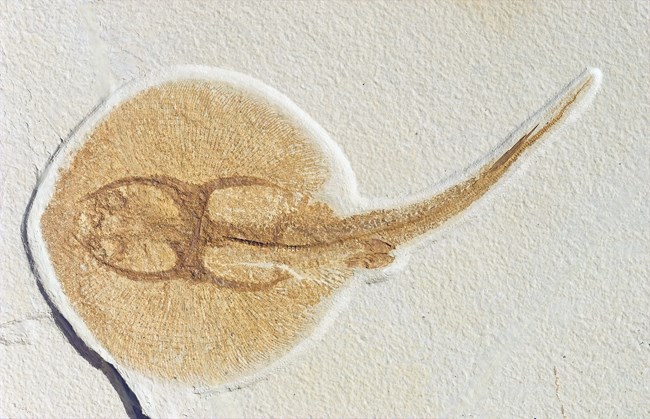
2.25 cm/8.9 in long catalog number FOBU408 NPS Photo Stingrays - 2 Species Identified: Heliobatis radians & Asterotrygon maloneyiOrder Myliobatiformes
There are almost 200 modern stingray species. Most are bottom-dwellers and feed on bottom-dwelling invertebrates, such as shrimp and crayfish. Stingray fossils are found in association with these invertebrates, indicating their ancient diet was similar to their modern relatives'. Modern freshwater stingrays are found in tropical river systems of South America, Asia, Africa, and Australia. 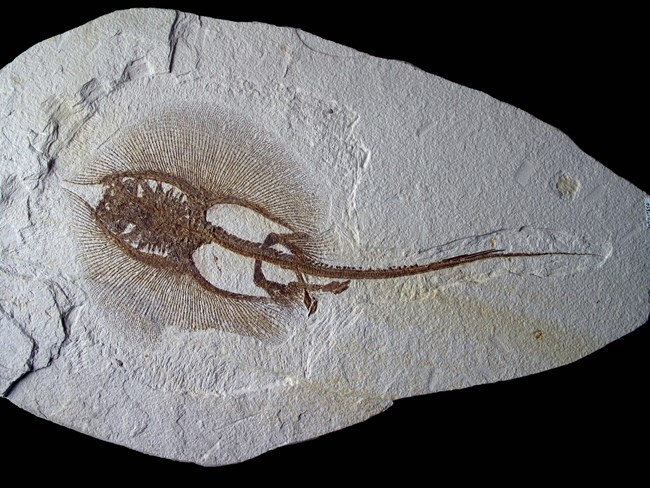
44.2 cm/17.4 in long catalog number FOBU17652 NPS photo 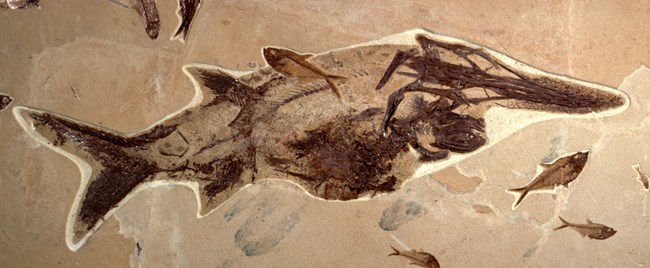
81.9 cm/32.3 in long catalog number FOBU7217 NPS Photo Paddlefish - Crossopholis magnicaudatusOrder Acipenseriformes, Family PolydontidaeC. magnicaudatus is often preserved with fish in the stomach, indicating this species was a predator. This fossil species is most commonly found in shallow-water deposits, but very few juveniles have been discovered. This could indicate that C. magnicaudatus matured and spawned in connecting rivers before migrating to Fossil Lake as an adult. This species' name, crossopholis, meaning 'fringed scale,' comes from the thousands of tiny, fringed scales covering its body. C. magnicaudatus reaches a maximum of five feet in length. Both modern paddlefish and C. magnicaudatus' snouts, or paddles, are lined with electroreceptor organs that allow them to navigate in dark or cloudy waters. There is one living species of paddlefish, Polyodon spathula, found only in North America. 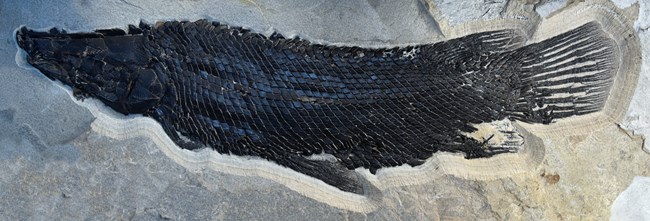
73.7 cm/29 in long catalog number FOBU14016 NPS Photo Gars - 4 Species Identified: Lepisosteus bemisi, Atractosteus simplex, Atractosteus atrox & Masillosteus janeiOrder Lepisosteiformes, Family LepisosteidaeSeven living gar species are found in freshwaters of North America, Central America, and Cuba. Of the 4 Fossil Lake gar species, all but one are very similar to modern gars. M. janei lacked the long jaw and sharp teeth characteristic of modern gars. M. janei teeth were instead rounded and flat, ideal for crushing small invertebrates like snails and crayfish. This gar species is primarily found in association with these fossil invertebrates. 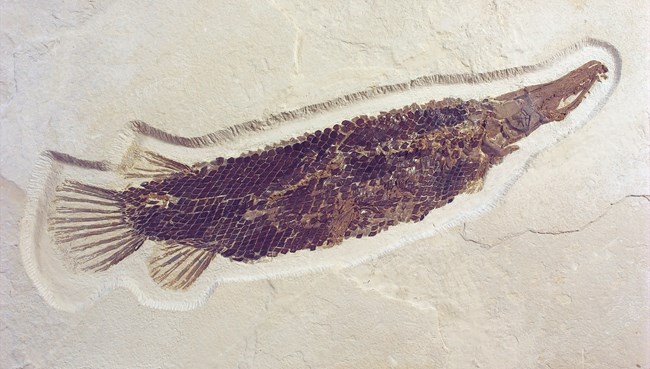
60 cm/23.6 in long catalog number FOBU788 NPS photo Modern gar species often migrate up rivers to spawn. This is a possible explanation for the lack of juvenile gar fossils found in the FBM. 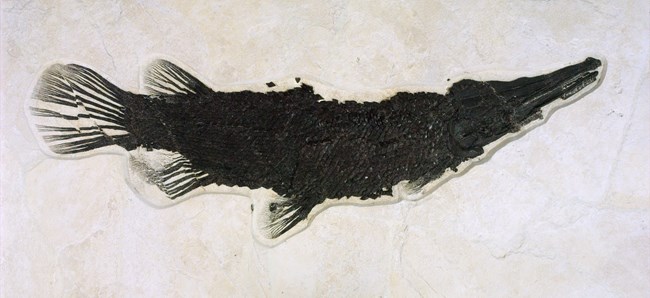
80.5 cm/31.7 in long catalog number FOBU13648 NPS photo 
200.4 cm/78.9 in long University of Wyoming specimen NPS photo Atractosteus atrox is not on display. 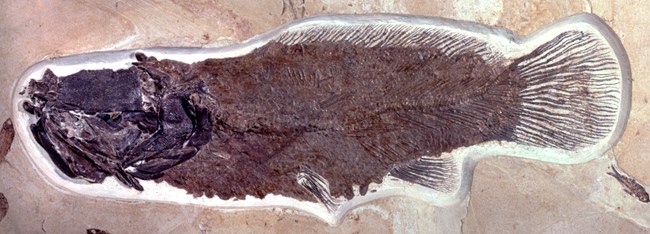
74.3 cm/29.3 in long catalog number FOBU7218 NPS Photo Bowfins - 2 Species Identified: Cyclurus gurleyi & Amia pattersoniOrder Amiiformes, Family AmiidaeThe genus Cyclurus is not known to have survived past the Eocene Epoch, possibly dying out about 35 million years ago. The closely related Amia genus survives today with the North American A. calva species. The long jaw and pointed teeth found on A. pattersoni specimens are indicators of a possible apex predator. 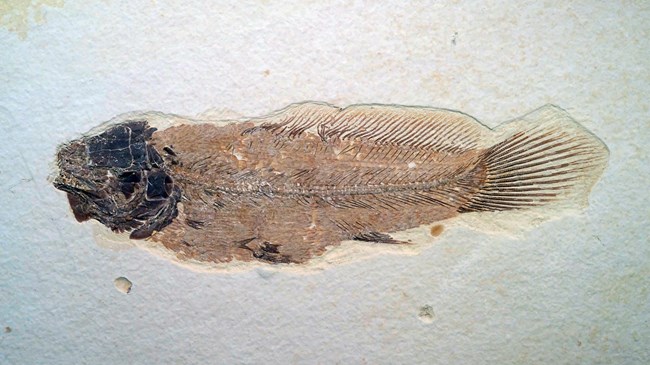
24.6 cm/9.7 in long catalog number FOBU14192 NPS photo 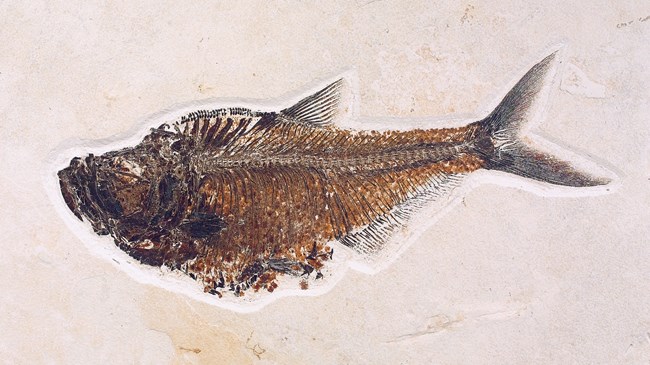
45.5 cm/18 in long catalog number FOBU791 NPS Photo Ray-finned Fish - Diplomystus dentatusOrder Ellimmichthyiformes, Family ParaclupeidaeD. dentatus is a primitive relative of the modern day herring. The genus Diplomystus is also known from fossil deposits in China. The last known species of the Ellimmichthyiformes order went extinct sometime in the middle Eocene. D. dentatus is the 2nd most common fossil fish found from Fossil Lake. Specimens ranging from embryonic size (about 0.7 inches) to full-grown adults (about 26 inches) are common. Smaller-sized specimens are more commonly found in mid-lake than near-shore deposits. This suggests that D. dentatus spawned in open water. This species' upturned mouth indicates it fed at the surface of Fossil Lake. D. dentatus specimens are commonly found with other fish stuck in their mouths, including other D. dentatus specimens. 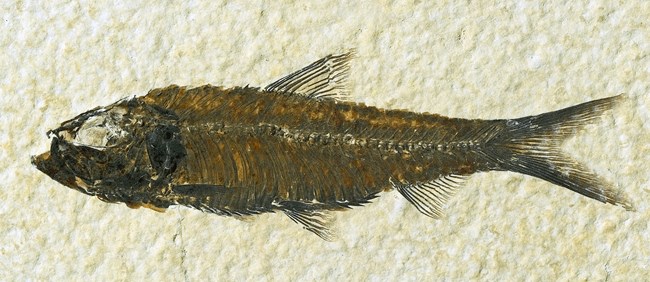
7.8 cm/3.1 in long catalog number FOBU13406 NPS Photo Herrings - 2 Species Identified: Knightia eocaena & Knightia altaOrder Clupeiformes, Family ClupeidaeThe Clupeidae family has an estimated 50 modern freshwater species. Clupeidae species can lay as many as 200,000 eggs at once, allowing species to multiply quickly. Modern species are also prone to mass die offs. K. eocaena is:
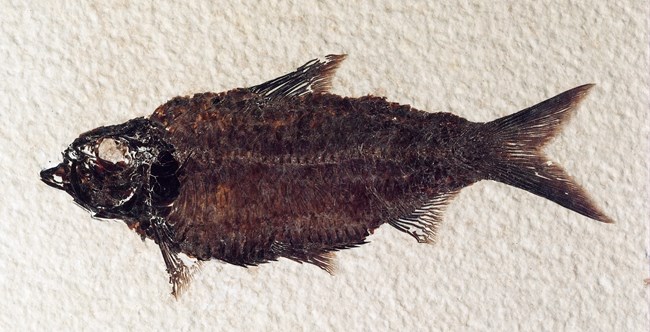
10.5 cm/4.1 in long catalog number FOBU13444 NPS photo K. eocaena specimens of all sizes are found in mass mortality plates, indicating this species schooled as both a juvenile and adult. The average adult size of K. eocaena specimens is about 6 inches, though specimens as large as 10 inches have been found. 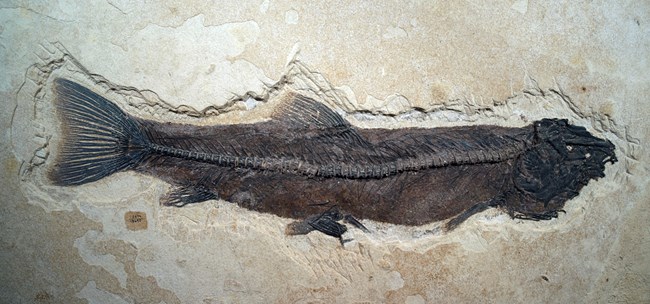
67.8 cm/26.7 in long Fossil Butte NM specimen NPS Photo Beaked Sandfish - Notogoneus osculusOrder Gonorynchiformes, Family GonorynchidaeN. osculus was the last survivor of the Gonorynchiformes order in North America. There are 5 modern species in the Gonorynchidae family that inhabit tropical marine regions of the Indo-Pacific Oceans. Very young juveniles and large adults are the only N. osculus specimens found from Fossil Lake. This could indicate that N. osculus was a migratory species. Their lifecycle may have consisted of: hatching in Fossil Lake, migrating to connecting streams to mature, and returning to Fossil Lake as an adult to spawn and die. N. osculus had a down-turned, sucker-like mouth. Its toothless mouth suggests that this was a bottom-feeding species. The highly salty water conditions at the bottom of Fossil Lake should have excluded most scavengers and bottom-feeders. Yet, N. osculus is found exclusively in deep-water deposits. This suggests that N. osculus spent most of its life outside of Fossil Lake in connecting rivers and streams. 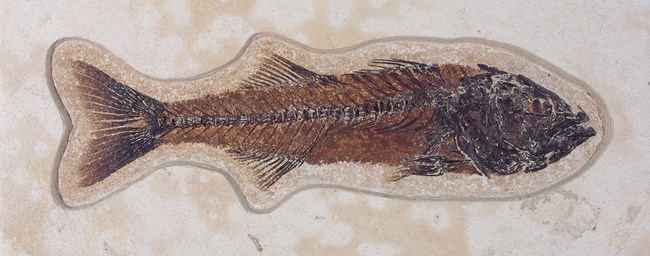
33.8 cm/13.3 in long BYU Idaho specimen NPS Photo Perches - 7 Species Identified: Mioplosus labracoides, Cockerellites liops, Priscacara serrata, Priscacara sp. a, Priscacara sp. b, Hypsiprisca hypsacantha & Hypsiprisca sp.Order Perciformes
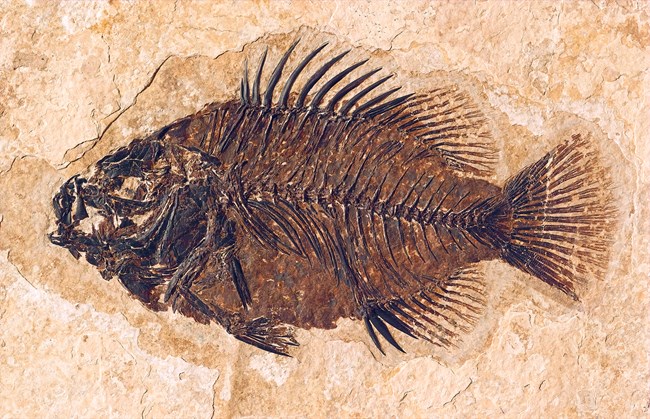
13.1 cm/5.2 in long catalog number FOBU428 NPS photo 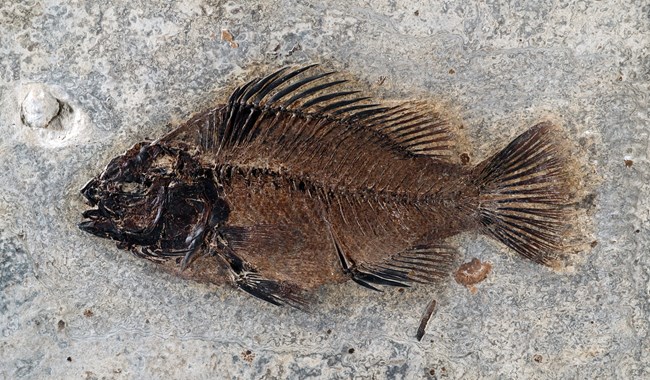
18.4 cm/7.2 in long catalog number FOBU14318 NPS photo
Priscacara sp. a has a much rounder body with eleven short dorsal spines.
Priscacara sp. b has four anal spines as opposed to the normal three. For a picture see Lance Grande's The Lost World of Fossil Lake: Snapshots from Deep Time page 168.
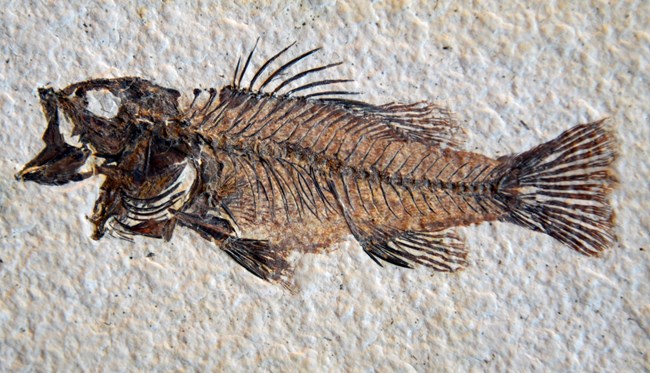
8.6 cm/3.4 in long catalog number FOBU13696 NPS photo 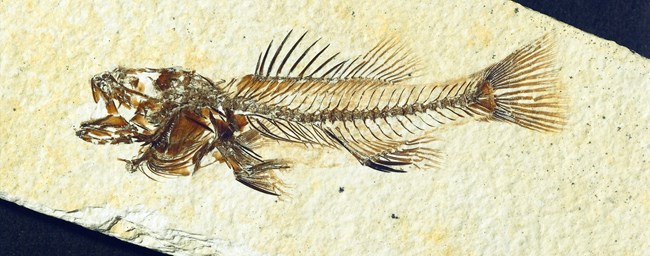
7.9 cm/3.1 in long catalog number FOBU13413 NPS photo 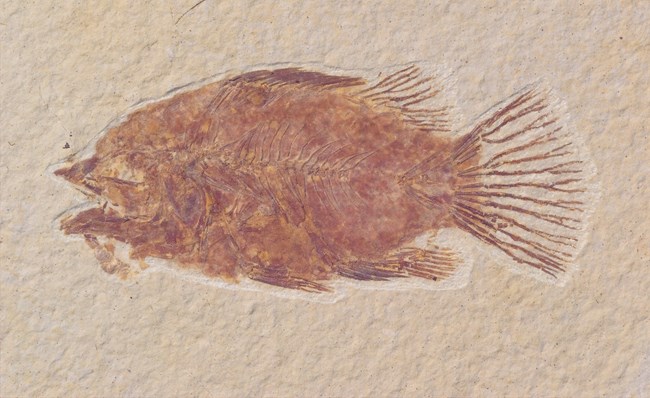
6.6 cm/2.6 in long catalog number FOBU13556 NPS Photo Mystery Fish - 2 species Identified: Asineops squamifrons & Asineops sp.Order Unknown, Family AsineopidaeA.squamifrons is known as the "mystery fish" as it lacks identifiable traits to place it in an order. It was assigned its own family and has since been joined by Asineops sp. Asineops appears to have gone extinct in the middle Eocene. 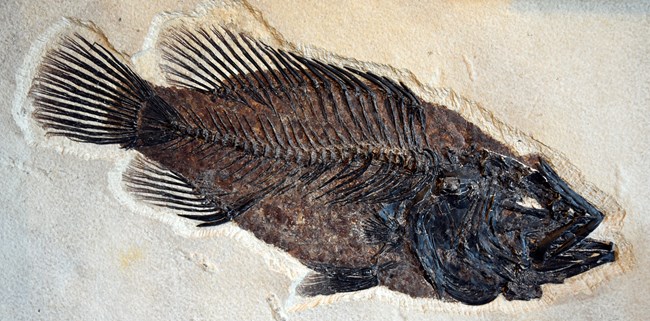
31.1 cm/12.3 in long catalog number 13729 NPS photo 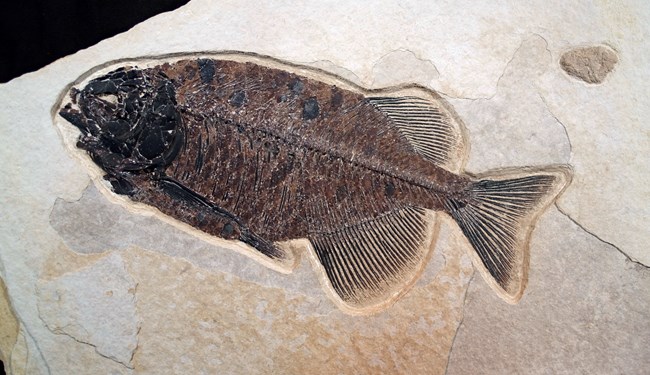
27.1 cm/10.7 in long catalog number FOBU17694 NPS Photo Bony-Tongue Fish - 2 Species Identified: Phareodus encaustus & Phareodus testisOrder Osteoglossiformes, Family OsteoglossidaeLiving members of the Osteoglossidae family include 10 species that live exclusively in tropical freshwaters in South America, Africa, Asia, and Australia. Modern Osteoglossidae are mouth-brooders (parents hold eggs and hatchlings in their mouths). 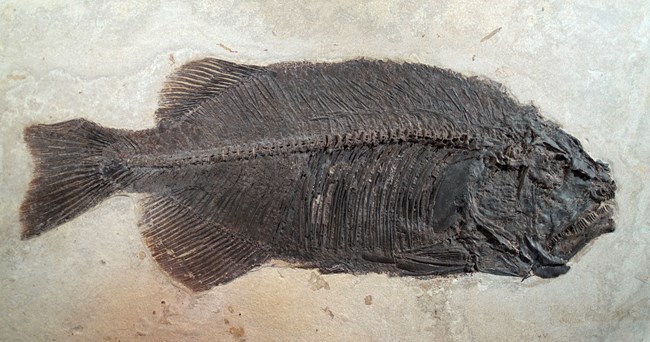
57.8 cm/22.8 in long catalog number FOBU790 NPS photo 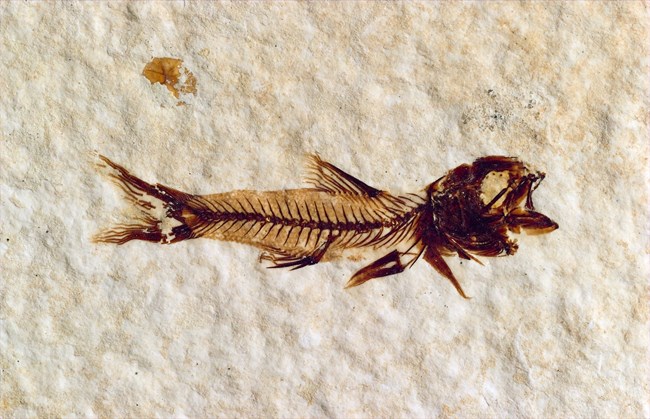
2.7 cm/1.1 in long catalog number FOBU11600 NPS Photo Trout-Perch - Amphiplaga brachypteraOrder Percopsiformes, Family PercopsidaeThe Percopsidae family has one modern genus with 2 species. They are restricted to freshwater rivers and lakes of North America. A. brachyptera is the earliest known member of the Percopsidae family, and is known exclusively from Fossil Lake deposits. Larval-size A. brachyptera specimens are almost completely absent from the FBM. This suggests that A. brachyptera spawned in rivers. A. brachyptera is also never found in mass mortality plates, indicating this species was solitary and not a schooling fish. 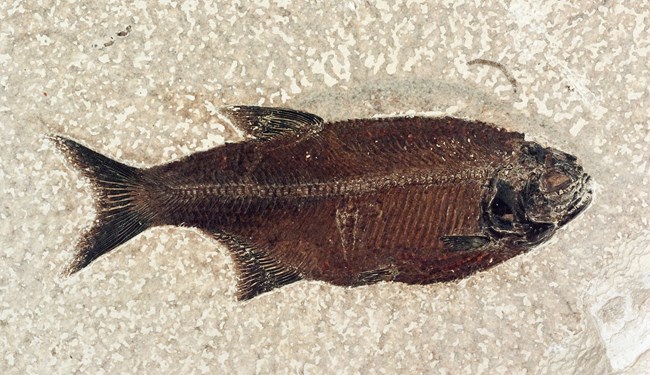
20.2 cm/8 in long catalog number FOBU13573 NPS Photo Mooneye - Hiodon falcatusOrder Hiodontiformes, Family HiodontidaeThere are 2 living species of the Hiodon genus that are found in freshwater in North America. They reach about 20 inches in length and feed primarily on insects. Fossil specimens of the Hiodon genus are known from both North America and Asia. H. falcatus is almost exclusively found in near-shore sediment from Fossil Lake. Most specimens are between 4 and 6 inches long, though some are as large as 10 inches. 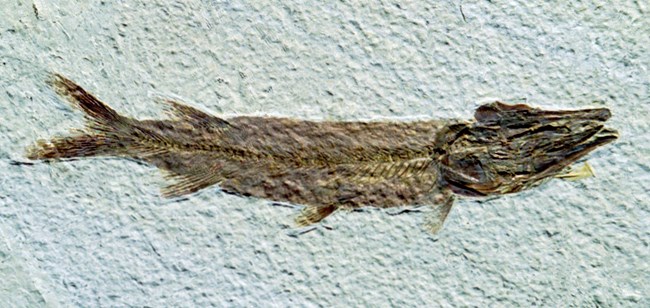
11.8 cm/4.7 in long Field Museum of Natural History specimen NPS photo Pikes and Pickerels - Esox kronneriOrder Exociformes, Family EsocidaeOnly a single specimen of Esox kronneri has been found. It may have lived in tributary streams, making it uncommon in lake sediments. The family Esocidae is a group of freshwater fishing known only to live in the Northern Hemisphere. There are seven species of Esox living today in North America, Europe, and Asia in cooler temperate regions. Pikes and pickerals are primarily piscavores but will occasionally eat other vertebrates and invetebrates. This species is not on display. ReferencesGrande, Lance. 2013. The Lost World of Fossil Lake: Snapshots from Deep Time. Chicago: The University of Chicago Press. |
Last updated: November 18, 2025
